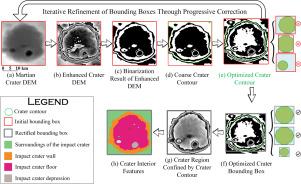Adaptive isoline interval optimization for precise contour segmentation and instance-level detection of Martian impact craters
IF 3
2区 物理与天体物理
Q2 ASTRONOMY & ASTROPHYSICS
引用次数: 0
Abstract
This study presents an adaptive method for optimizing isoline intervals for semantic segmentation and object detection of Martian impact crater contours based on Mars HRSC DEM data. The method uses an isoline interval division technique to improve the discernibility of terrain boundary features. This enhancement enables effective tracking and detection of closed contours of impact craters within the detection box. An energy function is designed for precise crater contouring, and a Bayesian optimization algorithm is applied to adaptively adjust contour intervals and optimize the contours. To address inaccuracies in the detection box, the paper proposes a progressively iterative correction method for refining impact crater target boxes. This method adjusts the width and height of the target box during iterations to make the bounding box tighten and fully enclose the impact crater. The position and size of the detection box are automatically optimized, thereby improving its accuracy. A pre-trained Segment Anything Model (SAM) is used to segment the morphological structures of the impact crater. Experimental results show that, for Martian impact craters larger than 3 km in the study area using Mars HRSC DEM data, the contouring accuracy achieved an mIoU of 69.75% and an mF1-Score of 80.51%. This substantially outperforms the performance of traditional watershed and depression filling contouring methods. The correction method improves the mIoU accuracy of bounding boxes within the study area by 7.49% for the YOLOv8 object detection network and 15.28% for the Robbins crater catalog database. The resulting high-precise crater contours, bounding boxes, and internal morphological features provide valuable inputs for deep space exploration and planetary science. The source code is available at https://github.com/shincccc/CraterContourSeg.

火星撞击坑精确轮廓分割和实例级探测的自适应等值线区间优化
提出了一种基于火星HRSC DEM数据的火星陨石坑轮廓语义分割和目标检测的等值线区间自适应优化方法。该方法采用等值线间隔分割技术,提高了地形边界特征的可分辨性。这种增强功能可以在检测框内有效地跟踪和检测陨石坑的闭合轮廓。设计了一种能量函数用于精确的火山口轮廓,并应用贝叶斯优化算法自适应调整轮廓间隔和优化轮廓。为了解决探测盒中的不准确性问题,本文提出了一种逐级迭代修正的方法来细化撞击坑目标盒。该方法在迭代过程中调整目标框的宽度和高度,使边界框收紧并完全包围陨石坑。自动优化检测盒的位置和尺寸,提高检测盒的精度。采用预训练的任意分割模型(SAM)对撞击坑的形态结构进行分割。实验结果表明,对于研究区大于3 km的火星陨石坑,利用火星HRSC DEM数据绘制的等高线精度达到了69.75%,mF1-Score达到了80.51%。这大大优于传统的分水岭和洼地填充轮廓方法的性能。该修正方法将YOLOv8目标检测网络和Robbins陨石坑目录数据库的边界框mIoU精度分别提高了7.49%和15.28%。由此产生的高精度陨石坑轮廓、边界框和内部形态特征为深空探测和行星科学提供了宝贵的输入。源代码可从https://github.com/shincccc/CraterContourSeg获得。
本文章由计算机程序翻译,如有差异,请以英文原文为准。
求助全文
约1分钟内获得全文
求助全文
来源期刊

Icarus
地学天文-天文与天体物理
CiteScore
6.30
自引率
18.80%
发文量
356
审稿时长
2-4 weeks
期刊介绍:
Icarus is devoted to the publication of original contributions in the field of Solar System studies. Manuscripts reporting the results of new research - observational, experimental, or theoretical - concerning the astronomy, geology, meteorology, physics, chemistry, biology, and other scientific aspects of our Solar System or extrasolar systems are welcome. The journal generally does not publish papers devoted exclusively to the Sun, the Earth, celestial mechanics, meteoritics, or astrophysics. Icarus does not publish papers that provide "improved" versions of Bode''s law, or other numerical relations, without a sound physical basis. Icarus does not publish meeting announcements or general notices. Reviews, historical papers, and manuscripts describing spacecraft instrumentation may be considered, but only with prior approval of the editor. An entire issue of the journal is occasionally devoted to a single subject, usually arising from a conference on the same topic. The language of publication is English. American or British usage is accepted, but not a mixture of these.
 求助内容:
求助内容: 应助结果提醒方式:
应助结果提醒方式:


